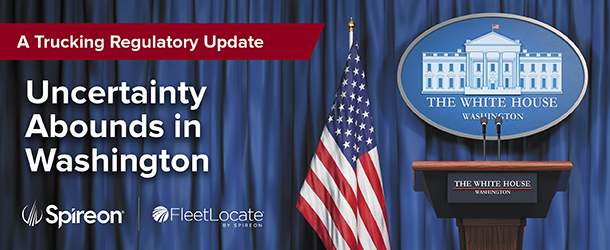By P. Sean Garney, Scopelitis Transportation Consulting
When a new presidential administration comes to town, the Washington, D.C. housing market heats up and the pace of government slows down, at least for a little while (and that’s not all bad right…). Thousands of political appointees from the prior administration pack their bags and seek ‘other opportunities,’ while a new group of appointees takes their place. Meantime, career federal civil servants find themselves reviewing their recent work to determine if it’s consistent with the policies of the new administration. When this happens in Washington, almost nothing else does. This pause in government can create uncertainty for businesses whose future planning and decisions are often tied to actions or policies the government may or may not pursue.
President Biden’s transition is no exception. And, when it comes to trucking, the industry looks to the Federal Motor Carrier Safety Administration (FMCSA) for information and guidance on what regulations might change, and how operations might need to adapt in the future. But, with no formal Administrator in place at FMCSA, and the new Secretary of Transportation focused on infrastructure legislation, little information is emerging on what the administration’s trucking regulatory priorities will be. But, if we look closely enough, we can find a few items whose near-term future seems certain. There are at least three, and they are…
1. Entry Level Driver Training (ELDT) – Beginning in February 2022, all individuals seeking a commercial driver’s license (CDL) for the first time, or hoping to update their current CDL class or endorsements, will need to take a version of ELDT. This rule was originally scheduled to become effective in early 2020, but technical challenges forced FMCSA to delay its implementation. Fortunately, this rule has widespread support among typically opposed stakeholders, meaning it is not expected to get caught up in any political shenanigans within the Biden administration.
Meanwhile, FMCSA has been full steam ahead on the IT build out that delayed the initial implementation. FMCSA recently hosted several webinars to update interested stakeholders, particularly truck driver training schools and related organizations. The agency has already published a development tool kit that provides trainers and States the information they need to begin their required integrations, and FMCSA expects to begin accepting training provider registrations this summer.
2. Clearinghouse CDL Downgrade Rule – When FMCSA began writing its Drug & Alcohol Clearinghouse rules, it envisioned a program that prevented drivers from operating a commercial motor vehicle (CMV) while disqualified for a drug or alcohol violation by requiring State licensing agencies (i.e., the DMVs) to query the Clearinghouse before issuing, renewing, transferring or upgrading a CDL.
When the Clearinghouse rule was finalized States resisted FMCSA’s efforts to require them to take licensing action against the driver, saying the Clearinghouse final rule merely required they check the Clearinghouse, but did not specify what action must be taken. Although surprised by the response from the States, FMCSA responded by initiating another rulemaking process to give more specific instruction. FMCSA published a proposal rule in April 2020, and interested observers expect a final rule from FMCSA sometime this year.
3. State Integration with the National Registry of Certified Medical Examiners (NRCME) – This is one regulation where all available signs point to yet another delay of a long-awaited safety process improvement. The trucking industry has been waiting since 2015 for the NRCME to be fully integrated with State licensing systems. This integration, currently scheduled for June 2021, will create a virtual connection between the medical examiner issuing a medical certification to a driver, and the State licensing agency.
This connection was originally conceived by FMCSA as a three-step process:
- First, the medical examiner would upload the results of a driver medical exam to FMCSA;
- FMCSA would then transmit those results to the State licensing agency; and,
- The State licensing agency would then update the driver’s motor vehicle record with new medical exam/certification information.
So far, only the connection between the medical examiner and FMCSA has been completed and drivers are still required to deliver their medical certificate/card to their State licensing agency to have their records updated. Those drivers who don’t deliver it to the State face the unnecessary prospect of having their license downgraded or suspended and being placed out of service during a roadside inspection, despite being fully qualified to operate a CMV.
In January 2021, the USDOT’s Inspector General (IG) issued a report that did not shine a favorable light on the prospects of an on-time implementation in June 2021. In its report, the IG cited technical IT challenges, including a hacking attempt that shut the system down for several months in 2018, as reasons FMCSA has not fully implemented this program.
The real news, though, is that it is unclear when the NRCME will be updated and that, once the technical problems are repaired, States will need between 6 and 18 months to update their systems to interact with the new Registry. This means truck drivers will continue to be left holding the bag for the foreseeable future.
Throughout the remainder of 2021, we will get a better sense of this administration’s trucking-related regulatory priorities. Until then, we can only rely on our experience and intuition to guide us on future government action. Expect positive action on ELDT and the Clearinghouse in 2021, and a step backward on the NRCME. If this information is important to you, keep a close eye out for President Biden’s first unified regulatory agenda.

